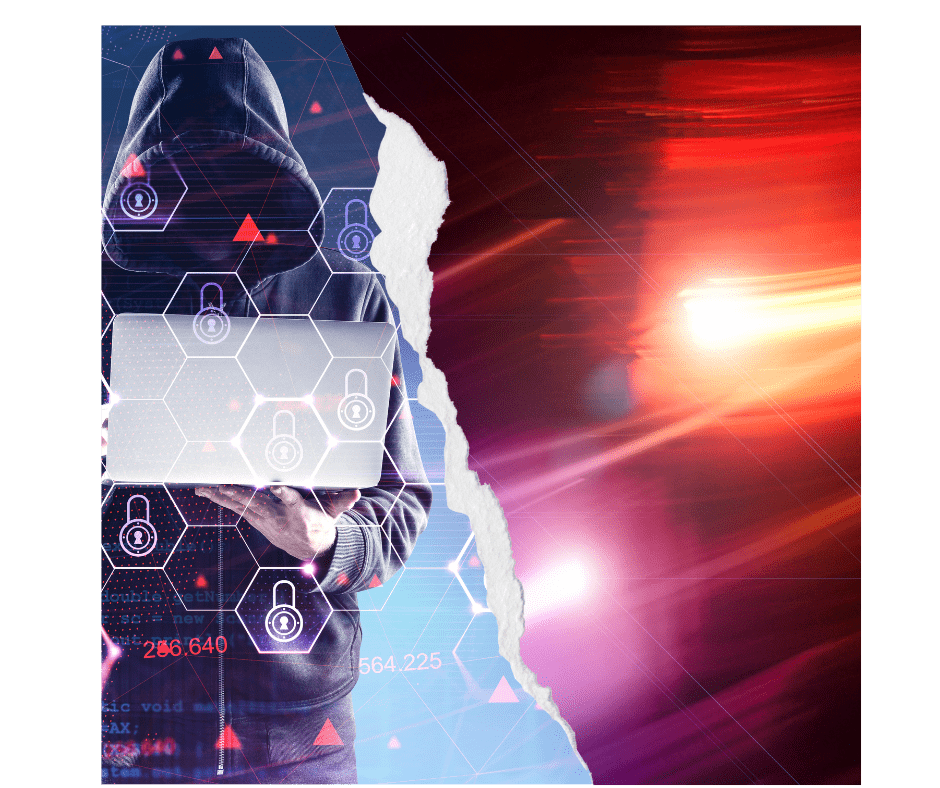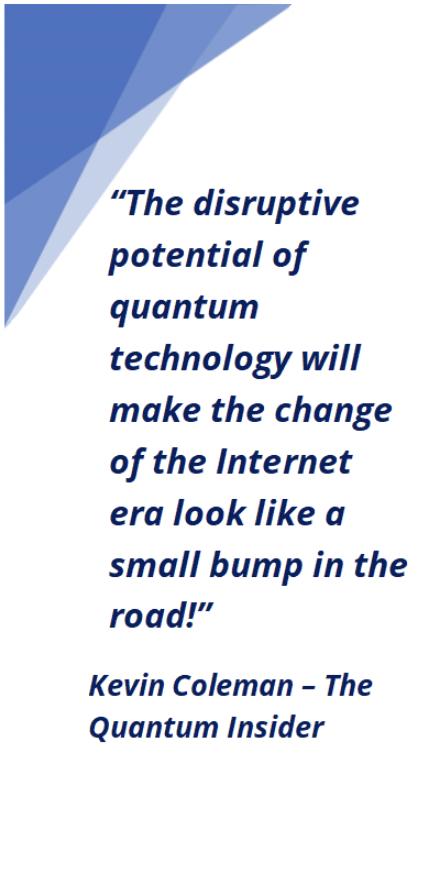Quantum computing, a cutting-edge field of technology, leverages the principles of quantum mechanics to process information. Unlike classical computers that use bits (0s and 1s) to process information, quantum computers use quantum bits, or qubits. A qubit can exist in a state of 0, 1, or both (superposition), and can also be entangled with other qubits, leading to an exponential increase in computational power. One tangible real-world example of quantum computing at work can be seen with Google’s quantum computer, Sycamore. In 2019, Sycamore performed a computation in 200 seconds that would take the world’s fastest supercomputer 10,000 years, achieving what is known as “quantum supremacy”.

Top Implications of Quantum Computing: Examples
- Revolutionizing Data Security: Quantum computers could potentially break contemporary encryption methods, posing significant security threats. However, they can also usher in new quantum encryption techniques, creating almost unbreakable codes.
- Transforming Machine Learning and AI: Quantum computing’s capacity to process vast amounts of data at unprecedented speeds could significantly enhance machine learning and AI algorithms, leading to more accurate predictive models.
- Accelerating Drug Discovery: In pharmaceuticals and biotechnology, the computational power of quantum computing can model complex molecular interactions, thus expediting drug discovery and making personalized medicine more attainable.
There Are Benefits to Quantum
Quantum computing offers numerous unique advantages that can be harnessed by technology leaders. Here are the top three benefits and their applications:
- Unprecedented Processing Speed: Quantum computers, with their ability to perform complex calculations at incredible velocity, vastly outpace classical computers. For technology leaders, this implies faster, more accurate simulations and projections, leading to better decision-making and strategy formulation.
- Superior Data Analysis: Quantum computers can analyze vast volumes of data simultaneously, a task traditional computers struggle with. Technology leaders can use this superior data processing ability to enhance operational efficiency, from load balancing in power grids, for example, to real-time monitoring of energy consumption patterns.
- Enhanced Security: The principles of quantum physics that underpin quantum computing also offer powerful new ways to encrypt data, making it theoretically impossible to crack. For CTOs, CISOs, and CIOs , this means a significant upgrade in data security, protecting sensitive operational data and customer information from cyber threats.
But There Are Risks, Too
Despite the impressive benefits, quantum computing is not without risks.
- Increased Vulnerability to Quantum Attacks: While quantum computing offers enhanced security through quantum encryption, it also presents an ironic risk. Quantum computing delivers the ‘harvest now, decrypt later’ dilemma. While it promises advanced security with quantum encryption, it simultaneously poses a paradoxical threat of decrypting data encrypted with today’s algorithms. Confidential and sensitive information that was previously secure will be vulnerable. Now is the time to promptly adopt quantum-resistant encryption techniques to mitigate the risk of having previously captured sensitive operational and customer data decrypted in the future. Future quantum computers could theoretically break current encryption algorithms, potentially leading to increased vulnerability to cyber-attacks. Failure to stay abreast of current quantum-resistant encryption methods creates the risk of exposing sensitive operational and customer data.
- High Implementation Costs: The transition from classical to quantum computing could be expensive . Not only does it entail acquiring or accessing quantum computing systems, but also investing in training personnel and overhauling existing infrastructure. These costs could trickle down to consumers in the form of rate and fee increases.
- Operational Disruptions and Recovery Costs: In the unfortunate event of a quantum-caused shutdown, restoring operations can be an arduous and expensive process. For instance, if a power grid were to fail due to a quantum-related cyber-attack, the outage could last several hours or even days, during which time power plants would have to run on backup power. The cost of such an event can be astronomical, encompassing not only the direct repair costs but also the indirect costs associated with service interruptions, such as lost production and emergency support.

One well-documented example of the costs of a cyber attack and its impact on operations is the 2018 incident involving the City of Atlanta. The city’s computer systems were hit by a ransomware attack, which affected multiple departments, including the utility services. The attackers demanded a payment of approximately $51,000 in Bitcoin. Unwilling to comply with the demands of the cybercriminals, the city chose to restore their systems independently. The recovery process, which included necessary upgrades to enhance security and prevent future attacks, ended up costing an estimated $17 million, a sum far exceeding the original ransom demand.
Top 10 Safeguard Steps to Protect Against Quantum Attacks
As quantum technology continues to evolve, so too must the strategies for securing networks and critical assets against potential quantum attacks. The following checklist provides a comprehensive set of measures that technology leaders can implement to fortify their networks against such threats. These measures range from technical upgrades to administrative policies, all geared towards ensuring the robustness and resilience of networks in the face of quantum-powered cyber-attacks.
- Upgrade Cryptographic Algorithms: Switch to quantum-resistant algorithms for encryption and decryption processes.
- Implement Multi-Factor Authentication (MFA): Enhance security by requiring multiple forms of verification to gain network access.
- Effective Asset Management: Identify and mitigate the risks posed by quantum threats, ensuring the long-term security and integrity of critical data an system. This can be the most overlooked step in mitigating risks in OT and IT environments.
- Regular Security Audits: Conduct frequent and thorough security audits to identify and address potential vulnerabilities.
- Backup and Recovery Plan: Establish a robust disaster recovery plan to minimize downtime and facilitate rapid recovery in the event of an attack.
- Software Updates: Regularly update all software applications to their latest versions to benefit from the most recent security patches.
- Network Monitoring: Implement real-time network monitoring to detect and respond to suspicious activities swiftly.
- Restrict Access: Limit network access based on job requirements to reduce exposure to potential threats.
- Partner with Cybersecurity Experts: Collaborate with cybersecurity firms to benefit from their expertise in quantum threat management.
- Employee Training: Educate employees about quantum threats and safe digital practices.
Tips for Implementing Quantum Computing
- Understand Quantum Fundamentals: Leaders should have a basic understanding of quantum computing principles. This understanding will enable them to make informed decisions regarding its implementation.
- Identifying Use Cases: Clearly identify the areas within the utility operations where quantum computing can bring significant improvements.
- Develop a Quantum Strategy: Formulate a comprehensive strategy that outlines the goals of quantum computing implementation, the resources required, and the potential challenges.
- Invest in Training: Invest in training the existing workforce about quantum computing. Skilled resources are essential for successful implementation and subsequent maintenance.
- Choose the Right Partners: Partner with quantum computing service providers that have a proven track record. Their expertise can facilitate smooth implementation and help avoid potential pitfalls.
- Evaluate Potential Risks: Assess the potential risks associated with quantum computing, such as quantum-powered cyber threats, and prepare accordingly.
- Pilot Program: Before a full-scale rollout, conduct a pilot program to observe the impact and effectiveness of quantum computing in the utility environment.
- Monitoring and Evaluation: Regular monitoring and evaluation after implementation are essential to ensure that the system is working as expected and to make necessary adjustments.

Helpful Resources for Developing a Comprehensive Strategy Around Quantum Computing
Quantum Computing for the Curious Website – Offering a unique combination of text and interactive exercises, this resource provides a comprehensive introduction to the principles of quantum computing.
Qiskit Website – An open-source framework for quantum computing. It provides tools for creating and manipulating quantum programs and running them on prototype quantum devices on IBM Q Experience or on simulators on a local computer.
Microsoft Quantum Development Kit Website – This kit includes the Q# programming language and quantum simulator, which allows users to build and test quantum applications.
Google Quantum Computing Website – Offers resources, research papers, and tools for quantum computing and its associated disciplines.
Quantum Computing Report Website – A valuable resource for staying updated on the latest news and developments in the field of quantum computing. It provides articles, vendor profiles, and educational resources.
Quantum Computing for Everyone Book – A book that provides an accessible introduction to quantum computing, explaining its concepts in straightforward terms.
NPTEL Quantum Computing Course Website – An online course that covers fundamental concepts of quantum computing and quantum algorithms.
U.S. Government Resources: Information for Ensuring Quantum Resilience
National Quantum Initiative Act Website – An Act passed by the U.S. government in 2018 to accelerate quantum research and development for the economic and national security of the United States.
Department of Energy Quantum Information Science Centers Website – As part of the National Quantum Initiative Act, the Department of Energy established five Quantum Information Science (QIS) research centers.
National Institute of Standards and Technology (NIST) Website – NIST conducts research to develop the measurements, standards, and technical leadership needed to make effective use of quantum systems.
Quantum Economic Development Consortium (QEDC) Website – Managed by NIST, the QEDC seeks to enable and grow the U.S. quantum industry.
National Science Foundation’s Quantum Leap Challenge Institutes Website – This NSF initiative provides funding for research and development in quantum information science and engineering.
Quantum Internet Blueprint Website – The Department of Energy’s blueprint towards a future secure Quantum Internet.
The Quantum World is Here
In this article, we’ve outlined the importance and potential impacts of quantum technology and its significant role in the United States’ economy and national security landscape. We’ve covered key basics and implications. We also touched on research in quantum information science, and we’ve offered a roadmap for business and industry leaders to create their quantum technology strategies.
As the quantum world is upon us, it’s crucial for leaders to stay ahead of the curve. For more information on how to safeguard your operations against the possible impacts of quantum technology, we invite you to reach out to Blue Ridge Networks, Inc. We’re eager to assist you with navigating this quantum landscape, and fortifying your entity to ensure our national security. https://www.blueridgenetworks.com





